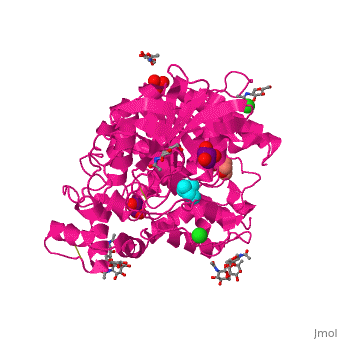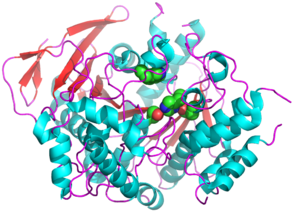Butyrylcholinesterase
From Proteopedia
Butyrylcholinesterase (BChE) is an enzyme widely distributed throughout the body in humans, but particularly prevalent in serum, where it occurs as a tetramer of catalytic subunits. It is distinguished from the homologous enzyme, acetylcholinesterase, by its ability to hydrolyze the non-natural substrate butyrylcholine as well as the neurotransmitter, acetylcholine. Its biological role remains obscure, but mutations in the human BCHE gene result in prolonged post-surgical apnea due to the inability of the mutant BChEs to hydrolyse the local anaesthetic, succinylcholine. BChE finds medical use as a bioscavenger for overcoming organophosphate (OP) nerve agent and insecticide intoxication by interacting rapidly with the toxic agents. Crystal structures of both the native enzyme and of its conjugates with nerve agents are available. The image at the right correspond to one representative BChE, i.e. the crystal structure of recombinant full length human butyrylcholinesterase (2pm8). 3D structures of BChEUpdated on 25-May-2014 hBChE - Apo human2pm8, 1p0i - hBChE - human BChE+OP irreversible inhibitors, including nerve agents and insecticides3djy, 3dkk - hBChE+tabun BChE+inhibitor binding at surface of the protein (far from the active site)2j4c – hBChE+ HgCl2 BChE + substrate analogues mimicking the binding of the substrate butyrylcholine1p0m - hBChE+choline Additional ResourcesFor additional information, see: Alzheimer's Disease
| |||||||||||
Proteopedia Page Contributors and Editors (what is this?)
Michal Harel, Alexander Berchansky, Lakshmi Venkatachalam, Joel L. Sussman, Jaime Prilusky, David Canner


